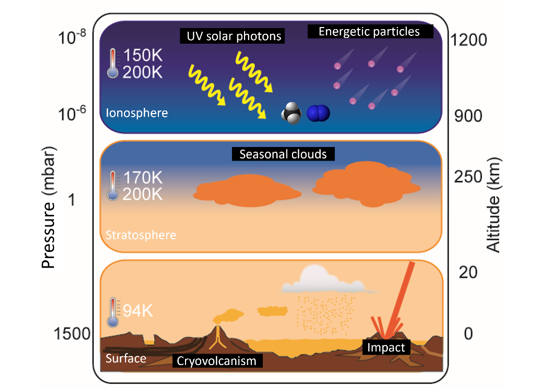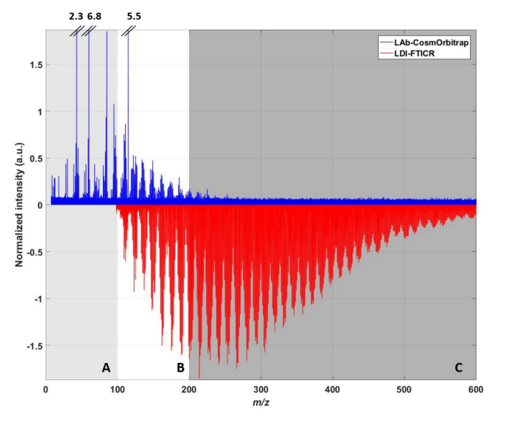- 1LPC2E, UMR CNRS 7328, Université d'Orléans, Orléans cedex 2, France (laura.selliez@cnrs-orleans.fr)
- 2Université Paris-Saclay, UVSQ, CNRS, LATMOS, 78280, Guyancourt, France
- 3Aix-Marseille Université, CNRS, PIIM, UMR 7345, Marseille, France
Introduction
Titan is a unique environment in the Solar System. By the complex organic chemistry occurring in its very dense atmosphere and on its surface, this moon is considered as a natural laboratory for astrobiology studies. In addition to the identifications of organic compounds that have been suggested [1-3], Titan houses also a subsurface liquid water ocean (with some liquid water bodies remaining at the surface about a thousand years).
Solar UV photons and Saturn’ magnetosphere electrons lead to the photo-dissociation and the ionization of the two main gaseous compounds of the Titan’ atmosphere, nitrogen N2 and methane CH4 (top, Fig 1). Simple organics are produced then reaction chains lead to more complex compounds to obtain solid organic aerosols. These aerosols form the haze of Titan and are organized in layers at different altitudes in the atmosphere. They are finally deposited at the surface (bottom, Fig 1).

INMS and CAPS are two instruments of the Cassini-Huygens space mission that have extensively studied the upper atmosphere of Titan. They have for instance detected positive ions and neutrals up to 100 u (limit mass range of the INMS instrument) and heavy positive and negative ions up to thousands of mass units [1]. For most detections (mainly done by the CAPS instrument) the mass resolving power did not allow to decipher the chemical composition or the growth pathways involved in the aerosols’ formation. On the Huygens lander, the Gas Chromatograph Mass Spectrometer has also recorded thousands of mass spectra during its descent in the atmosphere and at the surface of Titan [4].
Analogs of Titan’ aerosols
In addition to the large amount of in situ data obtained thanks to the Cassini-Huygens space mission and to go further in our understanding of this moon, many laboratory experiments produce analogs of Titan’ aerosols called tholins. One of them, the PAMPRE experiment [5] uses a radio frequency reactive low-pressure plasma to produce solid particles and solid films onto metallic surfaces placed inside the PAMPRE reactor, mimicking the coupled ion-neutral chemistry occurring in Titan ionosphere [1,6]. In this study, tholins are produced with a gas mixture of 5% of methane (CH4) and 95% of nitrogen (N2). We consider this matter as an analog of the ionospheric aerosols of Titan (top, Fig 1). This kind of analog helps to understand the formation mechanisms of these aerosols in the ionosphere and the nature of the chemical species produced. Other laboratory experiments like CHARTS and VAHIA chambers can simulate the photochemistry of Titan’ clouds using gas mixtures of benzene and hydrogen cyanide [7] deposited at 130K. Cooling at 70K, irradiation (around 230 nm and during various times) and room temperature heating are among the different steps to obtain an organic residue to analyze. This other kind of analog is representative of the stratospheric matter on Titan (middle part Fig 1).
The laser CosmOrbitrap-based mass spectrometer
This work aims at studying these ionospheric and stratospheric analogs by the identification and the quantification of the main chemical species. As the tholins produced in PAMPRE (ionospheric analogs) can be placed in the CHARTS chamber mimicking the stratospheric clouds, the other goal is to monitor the chemical evolution of these tholins from ionospheric to stratospheric conditions. A better understanding of the growth pathways is also expected.
Analyses are done with High Resolution Mass Spectrometry (HRMS). The technique used couples a laser ionization at 266 nm with the high-resolution mass analyzer CosmOrbitrap developed for future space applications [8]. This development led by LPC2E (Orléans, France) involves six laboratories and is funded by the CNES. The CORALS spaceflight prototype instrument that recently achieved Technical Readiness Level (TRL) of 5+ [9] is a laser CosmOrbitrap-based instrument developed in partnership with the University of Maryland and the Goddard Space Flight Center (GSFC). This instrumentation has demonstrated unprecedented analytical performances in the laboratory on a large organic samples range [10-13] including PAMPRE analogs [14] (blue, Fig 2).

Using the same instrument, another on-going study is investigating hydrolyzed PAMPRE solid tholins [15] to understand the evolution of the surface organic matter in contact with liquid water in a crater melt pool (bottom, Fig 1). In this project, stratospheric analogs are analyzed with the laser CosmOrbitrap-based instrument for the first time. Changes in the nature of the compounds and evidences of a higher chemical complexity is looked for.
Preparing the future exploration of Titan and other ocean worlds
Several mission concepts and instruments are currently in development or in preparation for the future exploration of ocean worlds. Among them and dedicated to Titan, the Dragonfly space mission is planned to be launched in 2028. As future astrobiology space mission payloads should include HRMS instruments to provide unequivocal identifications of biosignatures and prebiotic molecules, this work participates to demonstrate the potential of laser CosmOrbitrap-based instruments for the future exploration of ocean worlds.
Acknowledgments
We gratefully acknowledge the CosmOrbitrap consortium (LPC2E, LATMOS, LISA, IPAG, IJC Lab, J. Heyrovsky institute of Physical Chemistry), Alexander Makarov (Thermo Fisher Scientific) and the CNES for its technical and financial support.
We acknowledge the CORALS and AROMA teams, the NASA GSFC and the University of Maryland for a very fruitful collaboration.
LS also acknowledges the University of Orleans for the funding of this study (BQR project “MOT”).
References
[1] Waite et al. 2007, Science, 316
[2] Waite et al. 2009, Nature, 460
[3] Postberg et al. 2018, Nature, 558
[4] Niemann et al. 2005, Nature, 438
[5] Szopa et al. 2006, Planetary and Space Science 54
[6] Dubois et al. 2020, Icarus 338
[7] Mouzay et al. 2021, The Planetary Science Journal, 2
[8] Briois et al. 2016, Planetary and Space Science, 131
[9] Willhite et al. 2021, IEEE Aerospace conference
[10] Arevalo et al. 2018, Rapid Communications in Mass Spectrometry, 32
[11] Selliez et al. 2019, Planetary and Space Science, 170
[12] Selliez et al. 2023, Planetary and Space Science, 225
[13] Ni et al., 2023, Astrobiology, 23
[14] Selliez et al. 2020, Rapid Communications in Mass Spectrometry, 34
[15] Maratrat et al. 2023, Titan Through Time workshop
How to cite: Selliez, L., Maratrat, L., Couturier, I., Chatain, A., Vettier, L., Thirkell, L., Gaubicher, B., Colin, F., Lebreton, J.-P., Cernogora, G., Carrasco, N., and Briois, C.: Analyses of Titan’ tholins with High Resolution Mass Spectrometry based on the OrbitrapTM: from the ionosphere to the surface , Europlanet Science Congress 2024, Berlin, Germany, 8–13 Sep 2024, EPSC2024-779, https://doi.org/10.5194/epsc2024-779, 2024.